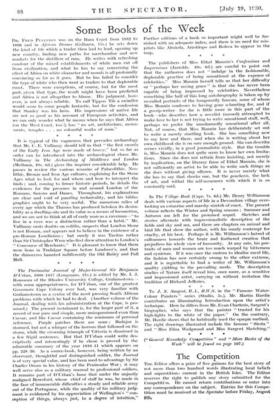It is typical of the vagueness that pervades archaeology that
Mr. C. E. Vulliamy should tell us that "the first swords of the Early Iron Age were made of bronze," but so far as order can be introduced into the archaeological chaos Mr. Vulliamy in The Archaeology of Middlesex and London (Methuen, 10s. fid.) gives the inquirer considerable help. Ile passes in review the various remains of Palaeolithic, Neo- lithic, Bronze and Iron Age cultures, explaining for the Stone Ages what to look for and where and how to interpret the finds ; and, coming to limier historic periods, he details the evidences for the presence in and around London of the Romans, Saxons and Danes. Throughout, his explanations are clear and void of puzzling technicality, and his biblio- graphies ought to be very useful. The numerous relies of every age which the Thames has produced betoken its desira- bility as a dwelling-site and its value as a means of locomotion, and we are not to think at all of early man as a caveman—" to live in a cave was a distinction rather than a habit." Mr. Vulliamy casts doubts on eoliths, suspects that London Stone is not Roman, and appears not to believe in the existence of a pre-Roman Londinium ; but surely it was Tacitus rather than Sir Christopher Wren who first drew attention to London's " Concourse of Merchants." It is pleasant to know that there were lions in Trafalgar Square before Landseer's, and that the rhinoceros haunted indifferently the Old Bailey and Pall Mall.
* * * *
















































 Previous page
Previous page